|
Thirty-five years ago, Frank Christensen started a revolution. He introduced his kit for the Eagle aerobatic biplane at the 1977 EAA Fly-In, and with that, he changed the image of homebuilding. Prior to that historic annual Fly-In.
Convention, no one had ever seen or even envisioned anything like the Eagle kit. On opening day it became the buzz of the convention, the thing to see, the new reason for building an airplane. Frank introduced his kit with such professionalism, so much class and theatricalism that suddenly all kinds of people realized that they, too, could build an airplane. And indeed they did.
The quality and thoroughness of the kits, the step-by-step “fail-safe” process detailed and richly illustrated in the construction manuals, and the option to order kits as needed, convinced people that there would be plenty of fun, education, adventure and excitement in working with one of Frank’s kits. He easily sold a hundred kits during the week at Oshkosh 1977.
The story of the Christen Eagle is a story of departure, of a fork in the road, a dramatic change in the progression and maturing of homebuilding. To fully appreciate that story, we have to go back to Frank’s roots, to the experiences that not only made the Eagle financially possible, but that imbued Frank with an attention to detail and a determination to see it all through.
He learned to fly at 16. He went off to Stanford to study industrial engineering and economics. He happened to be near a new movement in technology while it was still in its infancy: Silicon Valley. During his senior year at Stanford, he formed Tempress Industries, Inc. in Los Gatos, California, which became a leading manufacturer of miniature production tools and machinery for the fast growing microchip industry. In 1972, his company had grown to over 400 employees and was the sole source of critical products used in microchip production. He sold the company and went off to the World Aerobatic Championships as the team manager. According to Tom Poberezny, “Frank never missed a deadline, never overlooked a detail and made it all look seamless and easy.” A couple years later, Frank formed Christen Industries, Inc., in Hollister, California.
From here on, I’m going to let Frank tell his own story. Normally, I write up a series of questions in advance of an interview and send them to the person I want to interview. I did that with Frank. He didn’t wait. He sat down and wrote out answers to all my questions and upon reading his comments; I realized that I couldn’t improve on them. Typical Frank. When I called him for the interview, we had a wonderful chat, but I told him that I already had my story. I think you’ll agree. Here’s Frank’s Perspective on Homebuilding:
What got you interested in homebuilding? 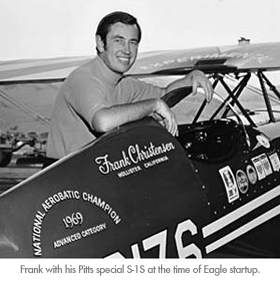
My interest in homebuilding was a by-product of an interest in aerobatic flying that emerged while being checked out in a Cavalier P-51 Mustang that I bought from Trans Florida Aviation in 1967. My instructor required that I do basic aerobatics in the Mustang, and when he observed my pleasure in this, he told me that if I really wanted to pursue aerobatics I should visit Curtis Pitts who made the Pitts Special. I soon became acquainted with Curtis, and he produced a custom homebuilt Pitts Special S-1S for me in 1968. Back home in Northern California, I shared it with a fellow pilot who joined me in self-teaching aerobatics, and we both entered aerobatic competition in 1969.
Having mechanical interests and experience, I did my own maintenance work on the Pitts with the occasional help of local aircraft mechanics and homebuilders who were curious about it. This made me aware of the world of aircraft homebuilding for the first time. I became intrigued with the processes, materials, and methods. My interest continued when I later purchased from Curtis a two-place S-2A that was produced at his new Afton, Wyoming, factory. Touring the factory and seeing the craft-oriented manufacturing processes was fascinating. It made me wonder what kind of special people built aircraft like this at home.
I started designing and making things to improve my Pitts, and this led to my designing and manufacturing for Curtis an inverted oil system, manual fuel pump system, and canopy for the Pitts S-2A. I eventually formed Christen Industries, Inc. and started offering these and other products to homebuilders as well.
.jpg)
This limited array of products was insufficient to support the small group of employees Christen had accumulated, so we were always looking for other products to produce.
When did you come up with the idea
for the Eagle and why did you decide to go ahead with the project?
I constantly complained to Curtis about deficiencies in my S-2A such as poor forward visibility, cramped and uncomfortable seats, lack of a canopy and excessive quickness on the runway. I tried unsuccessfully to get him to make improvements. He always said, “They’re buying it the way it is. Why change it?”
I eventually tried to buy Curtis’s company so I could improve the Pitts Special S-2A and add it to the Christen product line, but we couldn’t agree on a value. So, having experience in design, manufacturing, and aerobatic flying, I decided to try my own hand at producing a two-place aerobatic aircraft similar to the Pitts, but with better performance and appearance, and without the deficiencies I perceived. I was confident that my talented Christen team could do it. 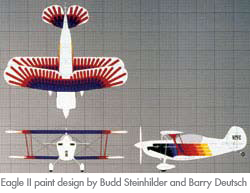
I envisioned an aircraft with more modern lines than the Pitts, a revolutionary paint design, and some creature comforts. The name, “Eagle” quickly came to mind, and I commissioned our industrial designers, Budd Steinhilber and Barry Deutsch, to develop a sporty and highly colorful “Eagle” paint design, and the concept of the Christen Eagle II (“II” for two-place) was born.
We originally intended to make the Eagle an FAA certificated production aircraft, and we prepared a complete FAR Part 23 certification package, but as the project proceeded, we realized that we would be competing with Pitts in an already limited market. We decided there would be a larger market for the aircraft as a homebuilt if it was offered in kits that were totally complete and accompanied by inviting illustrated instruction manuals that would enable anyone to build it. We thought that all pilots would be intrigued by the education and adventure of building their own high-performance aircraft if they were sure they could really do it safely, in reasonable time, and at moderate cost.
What kind of a team did you put
together for this project and what were you/they trying to accomplish?
During my years in the microchip industry, I had become acquainted with a group of people who eventually formed the team for the Eagle project. The group included an aircraft production technician experienced in wood, metal, and fabric aircraft, an A&P mechanic, an industrial designer, a draftsman, a technical illustrator, a technical writer, an advertising executive, a computer programmer, and a secretary. To compliment these talented people was an array of outside industrial suppliers that included machinists, sheet metal fabricators, welders, and industrial painters. Finally, there was a group of pilot friends. All had aviation interests of some sort, and all were sworn to secrecy.
We set out to produce a two-place aerobatic aircraft that could compete effectively with the Pitts S-2A as a result of better aerobatic performance, handling, appearance, comfort and convenience. The second objective was to develop a kit system by which the aircraft could be built in limited time by anyone with reasonable mechanical aptitude using only hardware store tools. There would be a series of kits, 26 in all, to be purchased and built one-at-a-time in a specific order until the complete aircraft resulted. Absolutely everything would be supplied in the kits including parts, materials, tools and highly detailed and illustrated step-bystep instruction manuals. The system would range from the ailerons kit all the way to a tie down kit, flight test kit, and aerobatic training kit.
How did you approach and ultimately satisfy the 51% rule…and how did the FAA respond to/work with your program? In other words, how did you get to that transformative photo of the man in the white coat will all the components of the kit laid out in front of him?
I must digress about the now-famous runway photo. The man in the white coat with the kit array in the foreground was a Christen draftsman photographed with the kit parts for the Eagle introductory advertisement and brochure—long before the FAA knew of the existence of the aircraft. For six months prior to the 1977 EAA Oshkosh Convention, we ran in Sport Aviation magazine a full-page black-and-white advertisement presenting a close-up of the head of a screaming eagle with the heading, “The Eagles are Coming!” Nothing else. This generated intense interest and curiosity in the sport aviation community.
 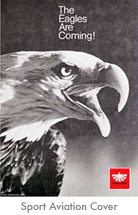 By the summer of 1977, the Eagle and its kits were ready, and in the August issue of Sport Aviation, we presented a four-page insert advertisement that featured the screaming eagle again on the cover, this time in full color with the heading, “The Eagles are Here!” Inside the insert was the runway photo with the aircraft and its kit parts array. On the back was a description of the kit system and an offer to supply an information package to interested parties. By the summer of 1977, the Eagle and its kits were ready, and in the August issue of Sport Aviation, we presented a four-page insert advertisement that featured the screaming eagle again on the cover, this time in full color with the heading, “The Eagles are Here!” Inside the insert was the runway photo with the aircraft and its kit parts array. On the back was a description of the kit system and an offer to supply an information package to interested parties.
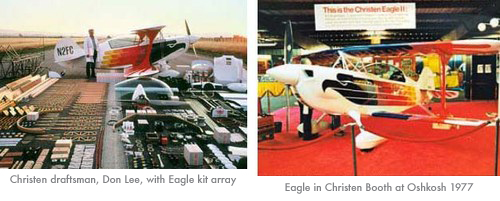 The curiosity was satisfied, but people now wanted to see the Eagle aircraft. The curiosity was satisfied, but people now wanted to see the Eagle aircraft.
Eagle in Christen Booth at Oshkosh 1977
The Eagle was introduced at the EAA Oshkosh Convention in August, 1977, where it was displayed in a large and sophisticated red-carpeted booth surrounded by sample kits and instruction manuals. It was a sensation, and we received more than 100 orders for kit sets by the end of Convention week.
Unfortunately, FAA personnel present at Oshkosh saw the frenzied interest and apparently envisioned that the sky would soon be clouded over by Eagles. They quickly circulated the rumor that the kit system was so complete that it did not satisfy the FAA 51% rule. We originally envisioned that building the Eagle would be basically a process of assembling from prefabricated parts and
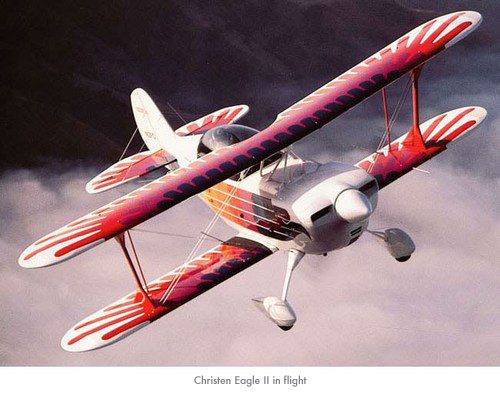 materials. There would be gluing, sanding, fitting and painting, of course, but no fabrication of parts from raw materials. We assumed that if the builder performed 51% of the labor to assemble the aircraft, the 51% rule would be satisfied. This approach had never been seen before by the FAA, so it raised new issues. materials. There would be gluing, sanding, fitting and painting, of course, but no fabrication of parts from raw materials. We assumed that if the builder performed 51% of the labor to assemble the aircraft, the 51% rule would be satisfied. This approach had never been seen before by the FAA, so it raised new issues.
In what ways did the EAA/Oshkosh
play a role in the success of the Eagle?
After the big splash at Oshkosh 1977 and the FAA reaction, we became concerned about the conformity of our kits with the 51% Rule. I made an appointment to meet with the senior authority at the FAA Engineering District Office in Los Angeles. I took with me to the meeting sample kits and sample instruction manuals. The meeting was brief. He didn’t look at the kits or manuals, and he simply said that the kit system did not qualify for amateur-built approval. When I asked why, he simply said the reasons were subjective, but that he had the authority to make the decision of behalf of the FAA. He had obviously made up his mind before I arrived.
Having invested much time, energy and money in the Eagle project, I was not willing to accept a subjective decision from the FAA. I asked Paul and Tom Poberezny for help, and they communicated with FAA officials in Washington who told their Los Angeles representative that his “subjective” explanation was not sufficient. They directed him to give me a detailed definition of what constituted amateur-built qualification under FAR Part 21, particularly as it related to aircraft construction kits.
In a second meeting, the FAA representative told me that for an aircraft to be amateur-built, 51% of the normally-fabricated parts (excluding the normally-procured parts such as engine, propeller, wheels, brakes, instruments and so on) must be fabricated by the builder from raw materials such as random lengths of wood, metal, plastic, fabric, and so on.
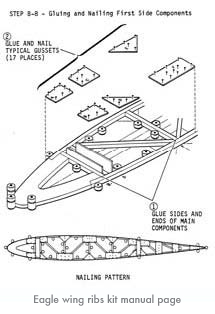 I had our computer programmer write a program to analyze the raw material contents of all the Eagle kits. It showed that the builder would fabricate less than 51% of the parts from raw materials; however, it also showed that the many wing ribs in the aircraft contained hundreds of simple spruce caps, struts and plywood gussets. If the builder cut these from random lengths of spruce and plywood, substantially more than 51% of the parts of the aircraft would be made from raw materials. So, we created wing rib kits that contained rib templates, saws, glue, nails, and an illustrated manual, and the FAA was forced to approve the Eagle kit system by their own definition. When word of the FAA approval got out, more orders started pouring in. I had our computer programmer write a program to analyze the raw material contents of all the Eagle kits. It showed that the builder would fabricate less than 51% of the parts from raw materials; however, it also showed that the many wing ribs in the aircraft contained hundreds of simple spruce caps, struts and plywood gussets. If the builder cut these from random lengths of spruce and plywood, substantially more than 51% of the parts of the aircraft would be made from raw materials. So, we created wing rib kits that contained rib templates, saws, glue, nails, and an illustrated manual, and the FAA was forced to approve the Eagle kit system by their own definition. When word of the FAA approval got out, more orders started pouring in.
How does the Eagle compare to the Pitts?
Many describe the Eagle inaccurately as a copy of the Pitts; however, there are no identical parts other than procured items like the engine, propeller, wheels, brakes, instruments, and so on. The wing size and airfoils are the same for both, but the Eagle has different ailerons and no dihedral in the lower wing, and the wood and metal structures are different. The Eagle has larger cockpit spaces with no aft instrument panel and a further aft CG to allow tighter aerobatic turning. The Eagle tail surfaces are a different shape and size with a different hinge design. The Eagle has a clean aluminum landing gear strut, whereas the Pitts has high-drag panel struts with bungee suspension. There are many other significant physical differences too numerous to mention. Pilots generally agree that the Eagle is faster with less drag and is lighter on the controls. It has a higher roll and pitch rate in aerobatics, and visibility and ground handling is significantly better. Equally important, the Eagle is better looking with its dramatic paint design, integrated canopy, clean landing gear and more streamlined shape.
How did you, Tom Poberezny,
Charlie Hillard and Gene Soucy come together?
We knew that Christen needed a really effective marketing program to overcome the entrenched popularity of the Pitts and to get pilots to consider homebuilding. The look of the Eagle and its groundbreaking kits did much to attract attention, but we needed to demonstrate it in the air to really draw people to it. Tom, Charlie, Gene and I had been good friends from our aerobatic competition days as well as the time we spent together in France at the 1972 World Aerobatic Championships. After the World Championships, they flew airshows in three Pitts Special S-1S aircraft using the name Red Devils while I was working on the Eagle idea.
Tom, Charlie and Gene had flown the Eagle, and Gene, in particular, was  impressed with it. He encouraged us to build a special competition-class super-light single-place version with a bigger engine and low-drag airframe. We did so, adding a mean and masculine black Eagle paint design, and we invited them all to fly it in the 1979 National Aerobatic Championships. They all flew, and Gene finished in second place after only two weeks practice in the new aircraft. impressed with it. He encouraged us to build a special competition-class super-light single-place version with a bigger engine and low-drag airframe. We did so, adding a mean and masculine black Eagle paint design, and we invited them all to fly it in the 1979 National Aerobatic Championships. They all flew, and Gene finished in second place after only two weeks practice in the new aircraft.
They all seemed impressed with the Black Eagle, so at the next EAA Convention, I got them all together at the side of the runway during the airshow and proposed that they abandon their Pitts Specials and the Red Devils name to become the Eagles Aerobatic Flight Team. In exchange, I would build three single-place Eagles like the Black Eagle, customized to their airshow needs, and I would provide flight uniforms, travel luggage, and promo-tional literature. They would retain their airshow fees and have no particular obligation to promote Christen or the Eagle except through their airshows. I would insure and maintain the aircraft to show-plane standards and provide advertising and product literature for them. 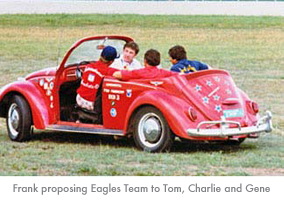
We agreed and shook hands, and the Eagles Team was born. There was never a written agreement between us. The Eagle I aircraft were completed for the following airshow season, and the rest is history.
We could not have expected more from the Eagles Team. Their stature gave pilots great confidence in the Eagle, and their performances stimulated sales of Eagle kits dramatically.
Do you know of any other kits out there 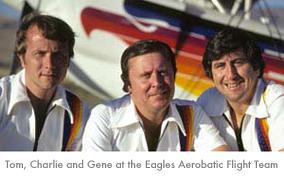
that are comparable the breadth and quality of the Eagle kit?
I have never seen any aircraft kits that are comparable in breadth and quality to the Eagle kits, particularly when the quality of the parts, the kit packaging and the illustrated instruction manuals are considered. I think most observers agree with this.
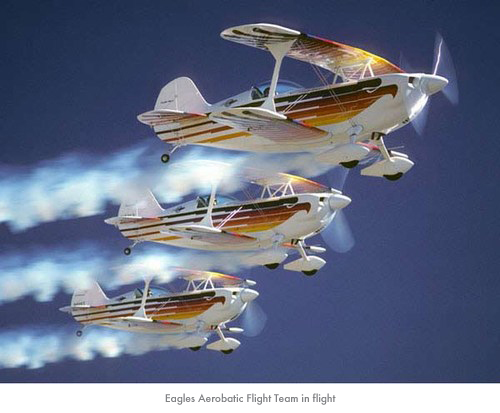
 What kinds of people have built Eagles? Were there What kinds of people have built Eagles? Were there
any surprises in the
demographic you attracted?
Eagles were built by people from all walks of life; doctors, lawyers, airline pilots, military pilots, women, trade schools—and people who were not pilots, but who just liked to build things. The latter group surprised us somewhat. Some pilots bought the kits and had friends or employees do the building for them, most notably, Thomas J. Watson, the retired Chairman of IBM and John Denver of country music fame.
 What are your thoughts about the state of homebuilding and EAA today? What are your thoughts about the state of homebuilding and EAA today?
I’m not in a locale where I can observe it much anymore, but I think homebuilding is probably alive and well. There may be a trend toward less skill and craftsmanship with the advent of composite designs and construction. I see a trend at EAA away from homebuilding toward conventional aircraft, warbirds, and Rutan space vehicles. This is evident from the change in content and advertising in Sport Aviation magazine. Hopefully, the do-it-yourself genes in people will live on, but the changes I see may be an inevitable by-product of changing technology, a bit like the fading of the craftsmanship of the blacksmith of early America.
What advice do you have for future designers/kit makers?
I don’t think I am qualified to give advice to designers and kit makers, since whether or not to design and manufacture is based on so many new variables and objectives today. I created the Eagle and its construction system because I thought that all pilots would enjoy the education, adventure, and accomplishment of building their own aircraft. I thought that the sequenced kit system and instruction manuals would make this possible, and I was convinced that if my team did it well, our venture would be successful and profitable. We succeeded in our time, but things may be different today. Even so, I continue to think that anything done really well usually finds its place in the world.
What led to the acquisition of Pitts
Aerobatics and the creation of Aviat Aircraft?
The aircraft factory in Afton, Wyoming, was originally established before World War II by Reuel Call as the Call Aircraft Company. They manufactured a touring aircraft named the CallAir, but operations were terminated by the War. After the war, they produced a crop duster named the CallAir A5. The company failed in 1959, and its assets were purchased in 1962 by an Afton businessman who formed the Intermountain Manufacturing Company (IMCO). In 1968, IMCO took a contract from Polaris of Minnesota to manufacture snowmobiles, but Polaris discontinued the Afton production in 1970, so the IMCO owner sought other products to manufacture with his skilled work force. At this time, Curtis Pitts had sought and received FAA certification for his Pitts S2A, and the IMCO people offered to manufacture the aircraft for him, and he agreed. Pitts Aerobatics was established in the Afton factory, and the Pitts S-2A was put into production in 1971. In 1977, Curtis Pitts sold his interest in the operation to the former IMCO owner and retired.
By 1982, the U.S. economy was in decline with interest rates having risen to astronomical rates as high as 20%. This slowed sales of Christen’s Eagle kits. Coupled with this was competition from a fleet of newly completed Eagles put on the market by homebuilders who needed money to deal with the poor economy. So, we concluded that we should complete FAA certification of the Eagle to move beyond the homebuilder market. At the same time, Pitts Aerobatics had also experienced declining sales from both the economy and inroads into their market made by the Eagle. The Pitts Aerobatics owner learned that we were considering certification of the Eagle, and he reacted by making it known that the Pitts product line could be acquired. We concluded that combining the Eagle kits with the Pitts certificated aircraft was the best solution to the sales challenges of both companies, and after brief negotiations, Christen Industries acquired the assets of Pitts Aerobatics in 1983.
The Afton factory had lower labor and overhead costs than Christen’s California factory, so the California production was moved to Afton in 1984 where all operations were consolidated with significant increases in efficiency, productivity, and profitability.
After the consolidation, we realized that the Afton factory had excess production capacity. To take advantage of this, we started design of an all-new utility aircraft to replace the retired Piper Super Cub for which there was unfilled demand. We did an analysis of Cub positives and negatives and started an all-new design. Although the Husky is somewhat similar in style to the Cub, it is an entirely different aircraft. The wing, ailerons, flaps, engine, propeller, tail configuration and landing gear are all different, and the structures and details borrow from the Eagle and Pitts. We received certification under Far Part 23 in 1987, only 18 months after development began, an FAA record for an all-new aircraft.
We produced Christen Eagle kits and Pitts S1-S, Pitts S1-T, Pitts S-2, Pitts S2-B, and Husky A-1 aircraft thereafter at peak rates as high as 100 total aircraft per year.
In 1990, I decided to retire from aviation to pursue other interests, and I sold Christen Industries to Aviat, Inc., a company formed by a British industrialist who had developed an interest in aviation. Five years later, he elected to sell the company’s assets to a new company named Aviat Aircraft, Inc. that was formed by a businessman from New York who also had aviation interests. Aviat Aircraft, Inc. continues to operate the Afton factory today, producing the Husky, Pitts, and Christen Eagle product lines.
What happened to the Black Eagle?
After the Christen operations were moved to Wyoming, I sold the aircraft to an aviation enthusiast who flies chartered 727s for a company in Alaska. He keeps it in a hangar in Texas where he flies it occasionally when there. He says he will never part with it because of its history and the fun of flying it. It’s still in mint condition with only a few hundred hours total time.
How did you organize the certification program for the Husky?
When I acquired Pitts Aerobatics (the Afton factory), E.H. “Herb” Andersen was the President and General Manager. Herb held an FAA DMER rating and had accumulated more than 30 years experience in aircraft design, certification, and manufacturing at Mooney Aircraft, Piper Aircraft, Aero Commander Aircraft, and of course, Pitts Aerobatics. He was extraordinarily able in all phases of aircraft design, development and production. He took responsibility for the basic Husky design, certification, tooling, and prototype development in Afton while I directed the detail design and drafting work with a team at the former Christen factory in California.  Herb really designed the Husky, and it was his experience, skill, and knowledge of FAA procedures that enabled us to certificate it in record time. My role was primarily financing, marketing, and occasional design input. Herb really designed the Husky, and it was his experience, skill, and knowledge of FAA procedures that enabled us to certificate it in record time. My role was primarily financing, marketing, and occasional design input.
If you had all to do over, is there anything you’d do differently?
I would probably do exactly the same, but I would put the Eagle kit instruction manuals on a website where the latest updated pages could be downloaded and printed to eliminate the monthly revisions we mailed to all Eagle builders. I would also make use of the Internet for marketing and order processing.
I would revel in undertaking the Eagle adventure again if I could find clones of the great Christen people whose knowledge, talent and skill enabled me to realize my vision. Unfortunately, many of them are gone now.
Frank sold Aviat Aircraft to Malcolm White, who sold it to Stu Horn, the current owner. Stu has advanced the Pitts Special to Model S-2C and has brought the Husky up to the model A-1C. Stu also sells kits for the Christen Eagle. For more information on any of these three aircraft visit www.AviatAircraft.com.
|



.jpg)


 By the summer of 1977, the Eagle and its kits were ready, and in the August issue of Sport Aviation, we presented a four-page insert advertisement that featured the screaming eagle again on the cover, this time in full color with the heading, “The Eagles are Here!” Inside the insert was the runway photo with the aircraft and its kit parts array. On the back was a description of the kit system and an offer to supply an information package to interested parties.
By the summer of 1977, the Eagle and its kits were ready, and in the August issue of Sport Aviation, we presented a four-page insert advertisement that featured the screaming eagle again on the cover, this time in full color with the heading, “The Eagles are Here!” Inside the insert was the runway photo with the aircraft and its kit parts array. On the back was a description of the kit system and an offer to supply an information package to interested parties.  The curiosity was satisfied, but people now wanted to see the Eagle aircraft.
The curiosity was satisfied, but people now wanted to see the Eagle aircraft.  materials. There would be gluing, sanding, fitting and painting, of course, but no fabrication of parts from raw materials. We assumed that if the builder performed 51% of the labor to assemble the aircraft, the 51% rule would be satisfied. This approach had never been seen before by the FAA, so it raised new issues.
materials. There would be gluing, sanding, fitting and painting, of course, but no fabrication of parts from raw materials. We assumed that if the builder performed 51% of the labor to assemble the aircraft, the 51% rule would be satisfied. This approach had never been seen before by the FAA, so it raised new issues.  I had our computer programmer write a program to analyze the raw material contents of all the Eagle kits. It showed that the builder would fabricate less than 51% of the parts from raw materials; however, it also showed that the many wing ribs in the aircraft contained hundreds of simple spruce caps, struts and plywood gussets. If the builder cut these from random lengths of spruce and plywood, substantially more than 51% of the parts of the aircraft would be made from raw materials. So, we created wing rib kits that contained rib templates, saws, glue, nails, and an illustrated manual, and the FAA was forced to approve the Eagle kit system by their own definition. When word of the FAA approval got out, more orders started pouring in.
I had our computer programmer write a program to analyze the raw material contents of all the Eagle kits. It showed that the builder would fabricate less than 51% of the parts from raw materials; however, it also showed that the many wing ribs in the aircraft contained hundreds of simple spruce caps, struts and plywood gussets. If the builder cut these from random lengths of spruce and plywood, substantially more than 51% of the parts of the aircraft would be made from raw materials. So, we created wing rib kits that contained rib templates, saws, glue, nails, and an illustrated manual, and the FAA was forced to approve the Eagle kit system by their own definition. When word of the FAA approval got out, more orders started pouring in.  impressed with it. He encouraged us to build a special competition-class super-light single-place version with a bigger engine and low-drag airframe. We did so, adding a mean and masculine black Eagle paint design, and we invited them all to fly it in the 1979 National Aerobatic Championships. They all flew, and Gene finished in second place after only two weeks practice in the new aircraft.
impressed with it. He encouraged us to build a special competition-class super-light single-place version with a bigger engine and low-drag airframe. We did so, adding a mean and masculine black Eagle paint design, and we invited them all to fly it in the 1979 National Aerobatic Championships. They all flew, and Gene finished in second place after only two weeks practice in the new aircraft. 


 What kinds of people have built Eagles? Were there
What kinds of people have built Eagles? Were there What are your thoughts about the state of homebuilding and EAA today?
What are your thoughts about the state of homebuilding and EAA today?  Herb really designed the Husky, and it was his experience, skill, and knowledge of FAA procedures that enabled us to certificate it in record time. My role was primarily financing, marketing, and occasional design input.
Herb really designed the Husky, and it was his experience, skill, and knowledge of FAA procedures that enabled us to certificate it in record time. My role was primarily financing, marketing, and occasional design input.